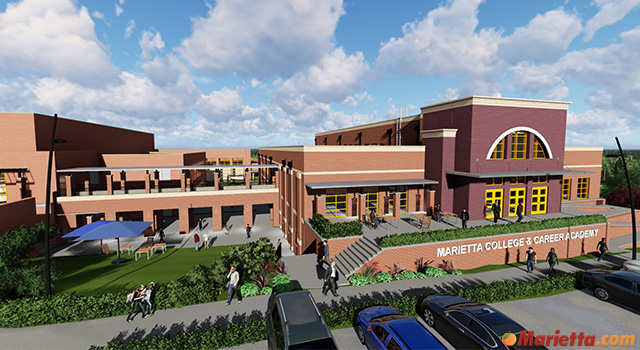In addition an International Baccalaureate school, Marietta High School will become a Georgia College and Career Academy. The addition of a new facility will allow for the growth and extended opportunities for students.
Marietta High School is continuing to grow and evolve for Cobb County students through the refining and deepening of its Career Pathways program. A significant part of that growth will happen as the school becomes an official Georgia College and Career Academy. The school already offers the International Baccalaureate World School Program, so this addition will further enrich its provisions for students.
Implementing the academy requires the construction of new facilities to help serve the school’s expanded education goals. Funded through E-SPLOST, the Georgia College & Career Academy state grant, and other state funds, these new facilities will include a 55,000-square-foot building, along with extensive modifications to many existing career pathway areas across the campus. The budgeted amount for construction of the new facility is $12.3 million.
Rather than a school within a school, all of Marietta High School will be a Georgia College and Career Academy. The new facilities simply will offer a means to address more careers options. “We are preparing each of our 2,454 students for a meaningful career aligned with career aptitudes and interests,” says Keith L. Ball, principal of Marietta High School. “We are purposefully aligning the Career Pathway offerings to opportunities in our community and region.”
Ball says career pathway offerings will include construction (which includes carpentry, electrical, plumbing, masonry and welding), cybersecurity, and healthcare (including biotechnology, a certified nursing assistant pathway, emergency medical responder, and sports medicine). Also included are pre-engineering, pre-architecture, early childhood education, culinary arts, marketing, public safety/law enforcement, film and video, graphic design, nutrition and food science, accounting, game design, and a plethora of performing and visual arts careers. An additional career pathway, Air Force JROTC, is the school’s largest student organization and is a premier way to develop leadership skills.
“Our post-secondary and industry communities have rallied behind our vision,” Ball says. “For example, Kennesaw State University offers a nationally recognized, four-year construction management degree, and we plan to have this opportunity as a possibility for our construction students. Our students are constantly interacting with real professionals in the fields they are choosing to pursue.”
The school uses an aptitude/interest instrument to help students determine their strengths; i.e., what they are naturally good at doing, says Tim Brown, Career, Technical, and Agricultural Education (CTAE) director and CEO of the College and Career Academy for Marietta City Schools. “This, along with information regarding students’ interests and passions, helps our families choose meaningful paths for students to explore, study, experience, and plan for leading a great career.”
Brown has a dual role in the school system. As CEO of the academy, he will champion and evaluate the program, and help to bring business and industry into the fold.
The new facility
The three-story facility will serve around 1,000 students, with a maximum occupancy of 1,096 people. It will house six, state-of-the-art labs; 11 classrooms; and additional supporting spaces for the labs and classrooms.
Breaux and Associates Architects designed the facility, and R.K. Redding has been involved in the design process as construction manager since the inception of the project. “As construction manager for Marietta City Schools, we work closely with the architect and the owner during the design and development stages of the project to check budgets for materials and methods, and perform feasibility surveys for different construction activities,” says Geoffrey Smith, vice president of construction and senior project manager, R.K. Redding Construction Inc.
After reviewing preliminary drawings for the project and taking off the dirt quantities for excavation and backfill, R.K. Redding discovered about 30,000 cubic yards of excess soils generated. “We knew that it would be very expensive to haul off excess soils that were generated by excavating the basement for the new College and Career Academy,” Smith says. “So, instead of exporting the soils offsite, we intend to build up the existing practice field grade and keep the extra dirt on site. This will save money for the school system.”
Smith said the new building was designed with elements to complement and enhance the existing facade of Marietta High School. The building is a traditional, steel structure with masonry and cast stone cladding. It will offer an abundance of natural light generated by aluminum storefront windows and door systems. It also will have an exterior insulation and finish system — synthetic, cementitious stone look — to complement the facade at the roof level.
The colors will match the existing building. The storefront is “Marietta gold.” The space for the College and Career Academy was designed to be cutting-edge in technology, while complementing the existing facility. Concrete masonry units (CMUs) will be used in the areas of refuge and egress, stairwells, and elevator tower. More than 260,000 bricks will be used to contact the face of the exterior of the building, Smith says.
Unique interior construction features of Marietta College and Career Academy include two key elements. Smith said the construction is more typical of retail storefronts and healthcare facilities. “The building’s interior is almost completely made up of drywall and storefront partitions, making this construction atypical of most school designs that are block walls and hollow metal doorways,” he said. “This design was utilized to make the space flexible in the future for changing and retrofitting existing labs for new technology and methods.
The other key feature of the facility is an interior space with a grand atrium area, which is more consistent of higher education facilities than K-12. “It will provoke the students to use its central core as a collaboration area,” Smith said. “One of the biggest design issues that had to be overcome with code compliance using this atrium was the use of a smoke evacuation system that is a unique design in itself. The area had to be ventilated, in case of fire and smoke infiltration.”
This ventilation requires the use of extremely large duct systems that have to be centralized in the open atrium. Rather than attempting to hide the ventilation in the walls, as a typical architectural design might, the ventilation was hidden in plain sight, using rails and tabletops in the atrium’s commons area. “Basically, since the ventilation would only be used in the case of a fire and smoke, the ventilation is now being used as part of the collaboration areas,” Smith says. “The large vents are now doubling as table space for project collaboration.”
Smith says the project completion date is set for December 2019 and will be a continuous operation until completion. Some work will be performed under a separate contract for the high school renovations that will take place after spaces in the College and Career Academy have been occupied. The spaces that once were part of the career and technical programs, initially housed in the existing high school facility, will be enhanced and upgraded in the College and Career Academy project. This will create repurposed or expanded space in the existing high school. These renovations are scheduled for phased construction between spring break of 2019 and end of summer 2020.

















